This is the second post in a three-part series written by Savannah Jackson; ed. assistance by Nancer Ballard.
In our last post, we introduced the character Dalinar Kohlin in Brandon Sanderson’s Stormlight Archive series. Although epic fantasy characters are traditionally expected to follow the Hero’s Journey, Dalinar’s story includes instead multiple cycles of both the Heroine’s and Healing Journeys. As the author Brandon Sanderson notes, “The book [series] started its life many years ago being about a young man who made a good decision. I wrote the entire book that way before realizing I’d done it wrong. So I started over from scratch and had him take the other fork, the more difficult fork. The fork that cast him into some of the worst imaginable circumstances, ground him against the stones of a world where there is no soil or sand on the ground. My goal [has been] to prove to myself, and to him, that the ‘good’ decision was not actually the best one.”
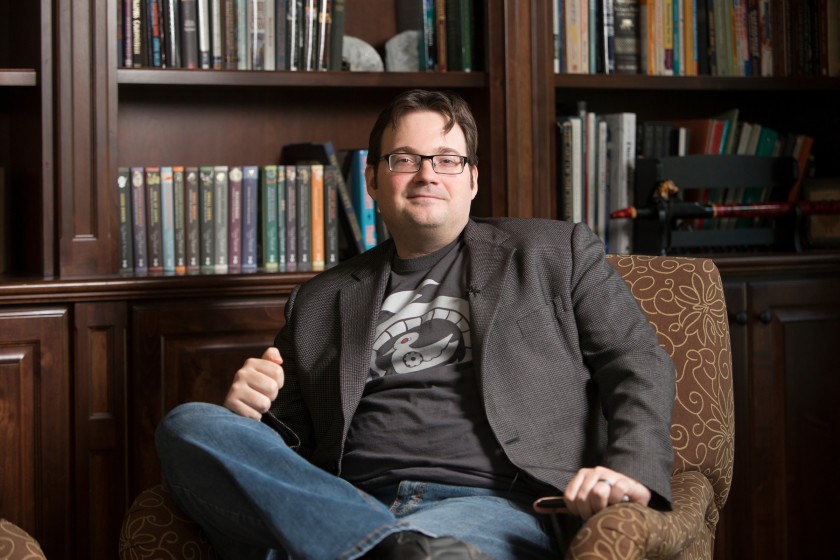
This quote speaks to the experiences of more than one character in the series, although we are focusing on Dalinar. Our first post explains how Dalinar’s initial trip through many of the stages of the Heroine’s Journey ends when he learns that the Almighty was long dead, before he finds a sense of wholeness. In the story this realization functions as a betrayal that upends his worldview and sends him on another cycle of the Heroine’s Journey. In Words of Radiance, the second book of the series, Dalinar Prepares for his (second heroine’s) Journey. He believes now more than ever that his purpose is uniting the Highprinces of Alethkar, his nephew’s kingdom. Although the belief that one has a special purpose as a leader is often a Hero’s trait, instead of desiring to become a dominant leader, Dalinar’s mission is to increase a sense of community, fight for the common good, and bring people together.
The Highprinces of Alethkar have been engaging in separate missions against their enemy, the Parshendi, in order to capture gemhearts, which are organic gemstones that harness magical energy. Capturing and possessing gemhearts is a means to increase wealth and prestige, and the missions have become a competition between Highprinces and a distraction from the real fight against the Parshendi. In the first book, Dalinar tried to join Highprinces on these missions to foster cooperation and community. After Sadeas’ betrayal (which is discussed in the first post), Dalinar tries to reduce internal competition by ordering the Highprinces to give all gemhearts to King Elhokar. This is a highly unpopular move that does not help Dalinar’s already failing soft power.
In his first Heroine’s Journey cycle in Book One, Dalinar experienced his Descent when he feared that the visions he had begun having meant that he was going mad. In the fourth stage of his second Heroine’s Journey cycle, Dalinar fears that he is a tyrant. Others try to reassure him that he is at least a benevolent tyrant and thus better than their currently weak king. Dalinar’s nephew, King Elhokar, is ineffective, young, and paranoid, but he is the rightful heir to the throne, and Dalinar doesn’t believe he has the right to supplant him and act as Alethkar’s leader.
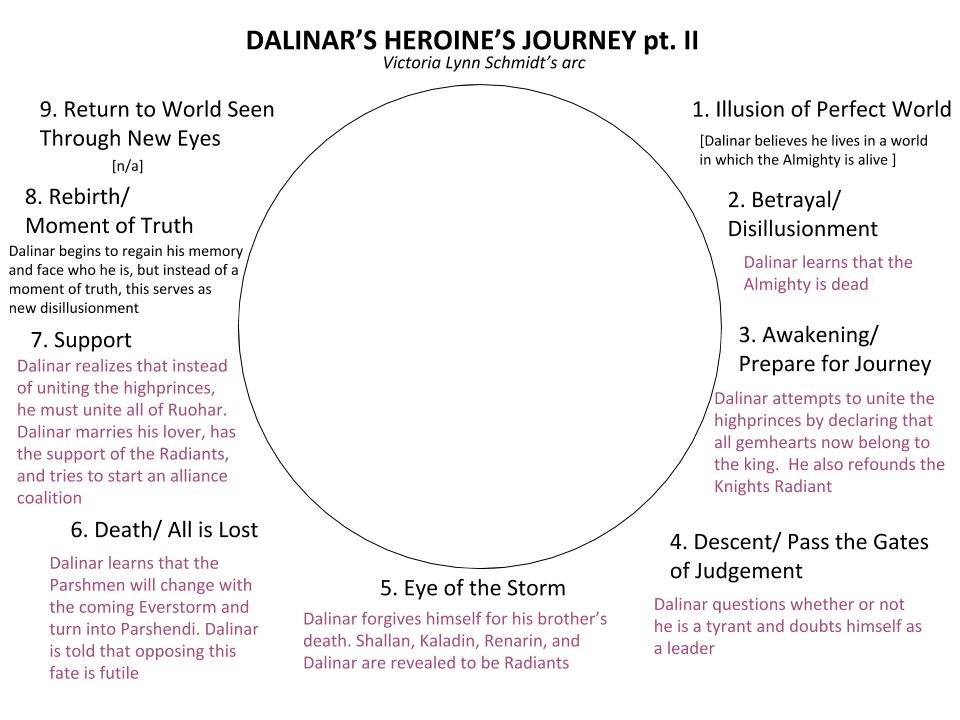
Dalinar’s Eye of the Storm occurs at the end of book two when he loses a fight with the man who assassinated his brother and accepts that he could not have saved his brother even if he had been sober at the time of his death. This realization helps Dalinar forgive himself for his brother’s death. Around this time, Dalinar also learns that he and three other central characters are Radiants with magical abilities. Their discovery leads the humans to believe that they may be better equipped to face the coming threats than they had feared.
All Is Lost when Dalinar learns that the Parshmen—nonhuman beings who seem to possess little consciousness and are extensively used as slave labor in Alethkar—will change into terrifying powerful creatures when a new, more destructive highstorm arrives. Dalinar’s visions tell him that fighting the oncoming threat is futile. However, Dalinar believes he has options regarding how to move forward since he is a Radiant and has the Support of the other Radiants. Dalinar attempts to gather further support by establishing a coalition with other leaders.
Instead, Dalinar collapses once more when he begins to recover memories that he had chosen to forget. His potential Moment of Truth quickly turns to debilitating Disillusionment that sends him on a Healing Journey and ultimately forces him into a third cycle of the Heroine’s Journey.
Dalinar begins to remember his deceased wife despite the fact that five and a half years ago, he solicited a magical “cure” for his pain that would make him forget her for good. He also begins to remember actions from his past which caused great harm to many others. Dalinar’s entire understanding of who he is changes, and he must once again reorient himself within and without, and face many hard realities that he never properly dealt with.
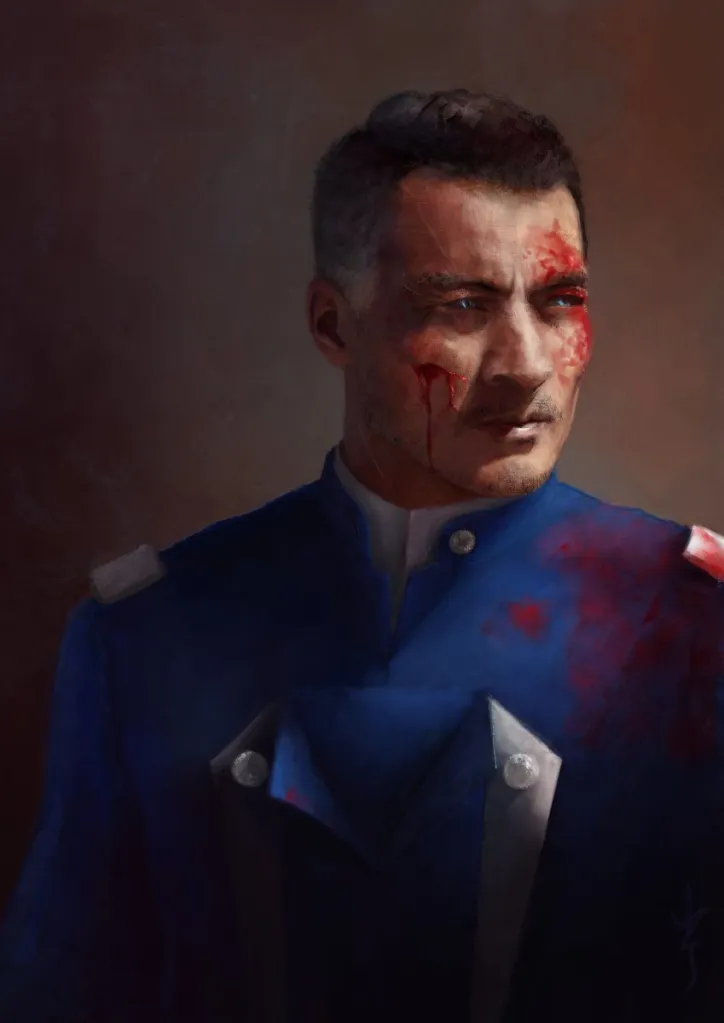
Thus far, Dalinar’s Heroine’s Journey has focused on his attempt to disentangle himself from the mythic lure of the warrior status. However, before Dalinar can continue on the third cycle of his Heroine’s Journey, he must find a way to confront and forgive himself for his violent past. Although Dalinar is an epic fantasy character, his struggle with his “heroic” (super-masculine) identity, his difficult relationships with his wife and sons, his use of alcohol and drugs as coping mechanisms, his reliance on adrenaline and rage, and his struggles to forgive himself for past harms, are painful challenges borne by many of us in real life.
The Hurt that starts Dalinar’s Healing Journey is the death of his wife, eleven years before the start of the first book. Readers do not learn of this until Dalinar begins to recover his memories in the third book.
While still a young warrior, Dalinar was married a foreigner, Evi ,in order to secure a Shardplate and Shardblade (see prior post for description) to aid his country’s expansionary war effort. Evi questioned Dalinar’s bloodlust and violence, and this tension between their worldviews culminated when she visited him at a war camp. She complained that he was so often absent that he did not even know his two young sons (who both adored their father as a legend). Dalinar was deeply affected by her pleas and promised to return home after the battle he was already engaged in. He tried to follow Evi’s advice and end the dispute through diplomacy instead of bloodshed, but when his efforts backfired, he became enraged and burnt the enemy’s city (called the Rift) to the ground. After the Rift was reduced to ruins, Dalinar learned that his wife had furtively snuck into the city in a last ditch effort to secure peace and had been imprisoned, and that by setting fire to the Rift prison, Dalinar had killed his own wife .
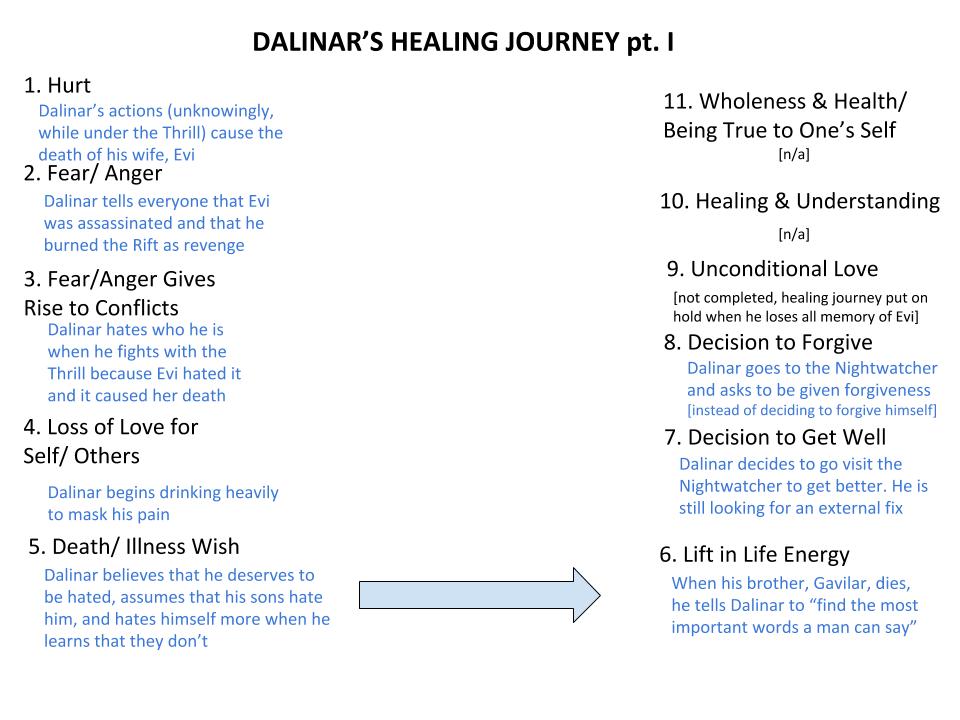
The second stage of the Healing Journey is characterized by fear and hurt as the wounded person tries to absorb and deflect the source of their wound. Dalinar’s Fear and Anger manifest most clearly when Evi’s burned corpse is brought back to the war camp. Dalinar and the few who know the truth tell everyone else that Evi was assassinated and the Rift burned as revenge. Spreading this false story serves their political purposes and allows Dalinar to deny the truth of what he had done. He directs anger at himself for killing Evi and lying about it. Four years after her death, Dalinar is still heavily burdened with grief and shame. He continues to fight in battles and experience the Thrill, but his anger, fear, grief, and shame create constant internal conflict (Stage 3), and he now hates who he is when fighting.
Unable to see a way to resolve his conflicts, Dalinar loses his ability to care for himself or others (Stage 4). He turns to drinking and drugs when he is not fighting and cannot mask his pain with the high of the Thrill. Dalinar tries to delude himself about his reliance on self-numbing and tells himself that his brother is throwing away all his drinks, but it is implied that Dalinar is actually drinking through what he purchases more quickly than he realizes. In a heart-wrenching scene, Dalinar’s young son, Renarin, brings him a small bottle of wine when Dalinar cannot find anything to drink, offering it as a gesture of care for his father. Renarin is too young to understand his father’s destructive drinking habits. Dalinar believes he deserves to be hated and hates his late wife, who he believes has convinced his own sons to hate him. When Renarin explains that Evi and the rest of the world have only good things to say about Dalinar and that they look up to him, Dalinar hates himself even more. He prays for release (eg. Death Wish, Stage 5), not caring what form this release takes.
In Healing Journeys it is often a slight, random, or even tragic event that leads to a small lift in energy that spurs the beginning of lasting change. Dalinar’s brother, Gavilar, is killed while Dalinar is drunk at a party. Dalinar blames himself for failing to protect his brother. But before his death, Gavilar asked his assassin to tell Dalinar to “find the most important words a man can say.” When this message is successfully relayed, it becomes a turning point. At his brother’s funeral, Dalinar makes the Decision to Get Well. He apologizes to his sons for being a poor father and decides to visit the Nightwatcher—a being who possesses Old Magic and is supposed to be able to “change a man.”
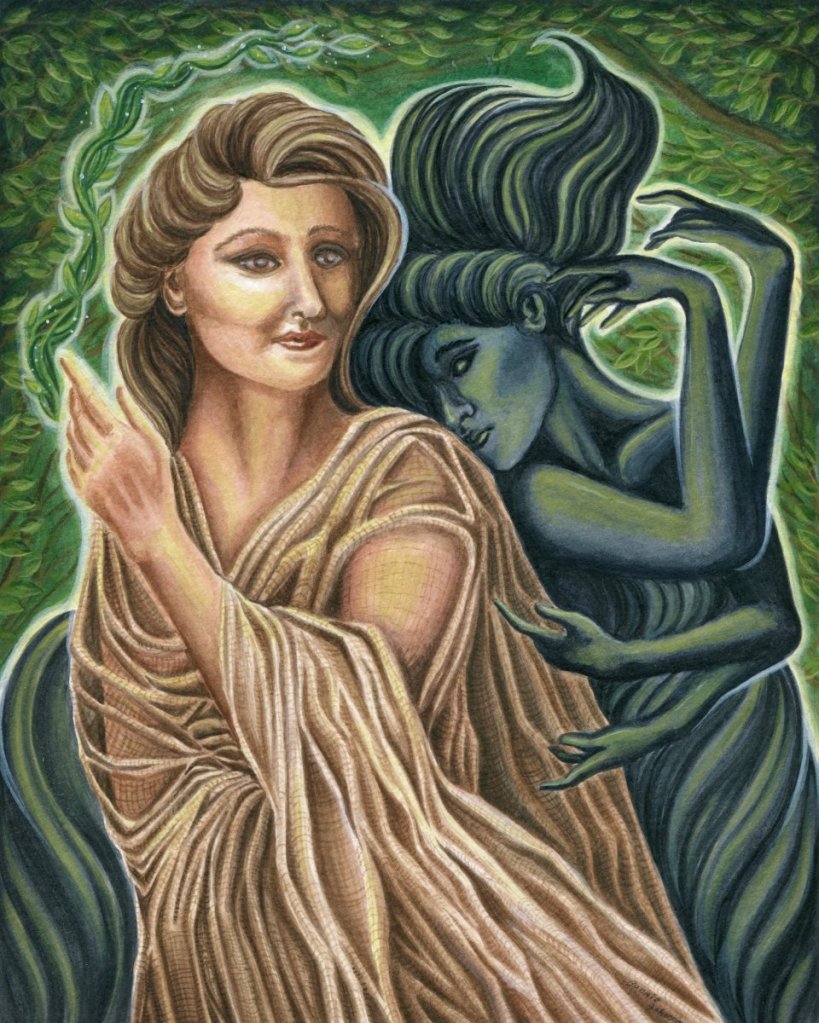
Dalinar goes to the Nightwatcher and asks for forgiveness. Although Dalinar is willing to give up alcohol and bloodlust as “fixes,” he is still looking for someone/thing external to take his pain and guilt away. The Nightwatcher can change men by giving them material possessions, skills, and power (hero’s traits of success). When Dalinar insists on forgiveness instead, Cultivation, who can be understood as goddess of growth and nurture, appears. At first she tells Dalinar that he has gotten what he deserves and is reluctant to offer help. But Dalinar isn’t ready to forgive himself and thus cannot unconditionally love himself. Eventually, Cultivation says, “I WILL NOT MAKE OF YOU THE MAN YOU CAN BECOME. I WILL NOT GIVE YOU THE APTITUDE, OR THE STRENGTH, NOR WILL I TAKE FROM YOU YOUR COMPULSIONS… BUT I WILL GIVE YOU… A PRUNING. A CAREFUL EXCISION TO LET YOU GROW.”
Cultivation explains that the cost will be to lose all memories of Evi. In his pain and desperation, Dalinar believes that he never deserved Evi to begin with and he accepts the goddess’ offer. Evi becomes a blurry memory. Dalinar cannot remember what she looked like, nor any specific interactions they had. Even her name sounds to Dalinar like mere rushing air when it is spoken out loud by others. Having forgotten all events related to his wife, he accepts the lie that his wife was assassinated and the Rift burned as revenge. Dalinar’s healing journey stalls.
When Dalinar’s memories begin to return five and a half years later, Dalinar begins the second round of his Healing Journey. He remembers his wife’s name, and this memory re-ignites his Hurt. He does not yet recall all the events that led to Evi’s death, but he knows that Evi’s death led to his years as a drunkard and his decision to visit the Nightwatcher. He is confused as to why his memory is now returning since the Nightwatcher’s curse (the exchange for her gift of change) has never been known to disappear before.
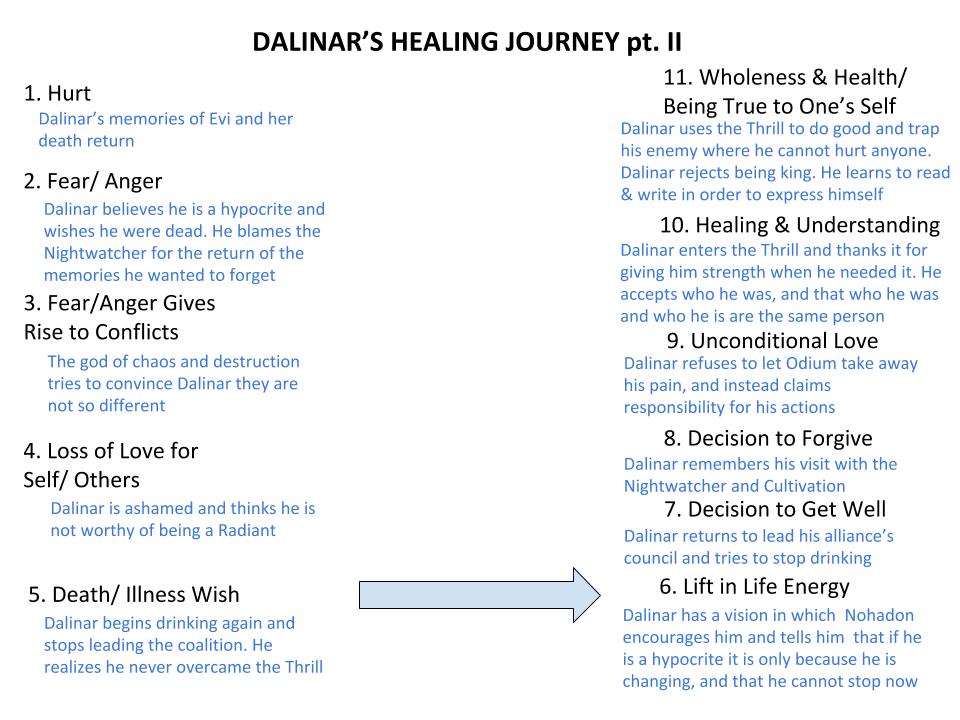
As his memories return, Dalinar must face his Fear and Anger again. He feels like a hypocrite for condemning others who have killed innocents to obtain power when he himself has done the same for less. He hates the popular myth that he fights ruthlessly but with fairness and honesty because he now knows that it has always been a lie. As he Loses Love for Himself and Others once more, he questions how he can live with this returned pain and again expresses a Death Wish. He thinks that if there were any justice in the world, he would have been killed long ago. However, Dalinar now believes that “wishing for ignorance” is “the coward’s route.” Dalinar realizes he cannot return to ignorance and avoidance, even though he does not yet think it possible to face his past.
Meanwhile, Odium, a god of chaos and destruction who has killed other gods, including he Almighty, is now trying to kill Cultivation. Odium describes himself to Dalinar as “emotion incarnate,” and tries to convince Dalinar that he and Odium are not so different. Dalinar begins to believe he is dishonorable and not worthy of being a Radiant. The Alethi capital city falls, the king is killed, and Dalinar recovers his full memory of the destruction of the Rift. All of his coping mechanisms have failed him; he realizes that he never truly overcame the Thrill and the ancient ethical guide, the Way of Kings, no longer comforts him. Dalinar starts drinking heavily again and abandons his leadership of the coalition.
This time his Lift in Energy is the result of a dream/vision in which he talks with the philosopher author of the Way of Kings, Nohadon. Nohadon gives advice that Dalinar once told someone else, pointing out that a hypocrite is “nothing more than a man who is in the process of changing.” Echoing Dalinar’s brother’s words (to find the most important words a man can say) in a slightly different form, Nohadon encourages Dalinar to search for “the most important step a man can take.” Dalinar again makes a commitment to Get Well.
Dalinar again reaches Stage 8—the Decision to Forgive. His memory of meeting the Nightwatcher and Cultivation returns, helping Dalinar to realize that he must forgive himself, not be forgiven by others or simply ask a higher power for forgiveness. Once Dalinar realizes he must forgive himself, he is finally able to move forward toward Unconditional Love. Dalinar finally claims responsibility for Evi’s death and on the battlefield, he refuses to let Odium take his pain. He reaches Stage 10–Healing and Understanding–when he enters the Thrill and instead of becoming lost within it, thanks the Thrill for giving him strength in the past and leading him to his current understandings. He is able to look back at the man he was when he burned the Rift and say, “I understand you,” and know that that his past self and current self are one person.
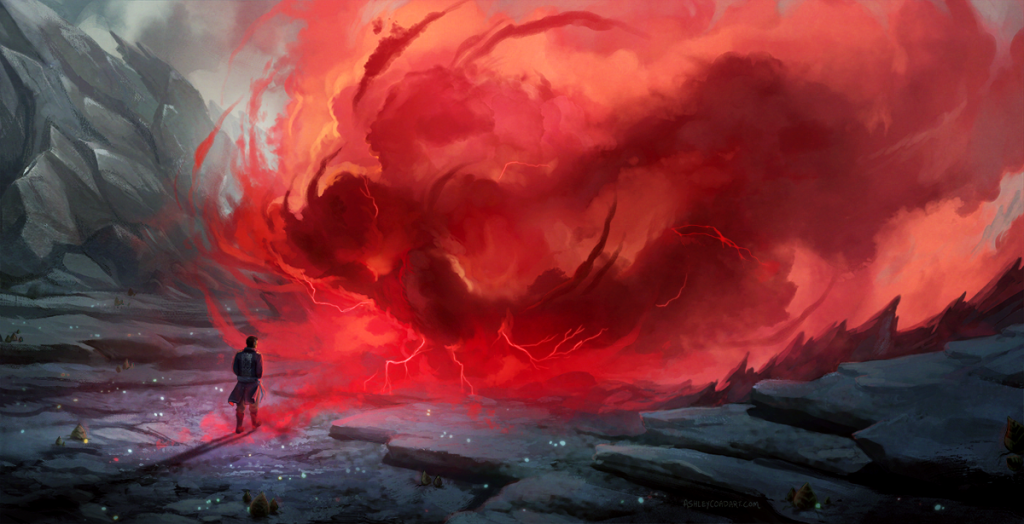
At the end of the third book, Dalinar achieves the final stage of the Healing Journey. He rejects the possibility of being king and begins to learn how to read and write (which is socially taboo for men in his country). Writing becomes a new way to express himself that has nothing to do with violence or bloodshed. Dalinar accepts his pain and responsibility for what he has done. He realizes that he cannot be himself and help those around him if he tries to compartmentalize his experiences and live an existence devoid of pain. With this acceptance, Dalinar faces the uncertainty of the continuing war.
In our next and final post, we will examine Dalinar’s third cycle of the Heroine’s Journey, which occurs concurrently with his second Healing Journey and in which his forgiveness of himself is crucial to forming his new understanding of the world and his place within it.
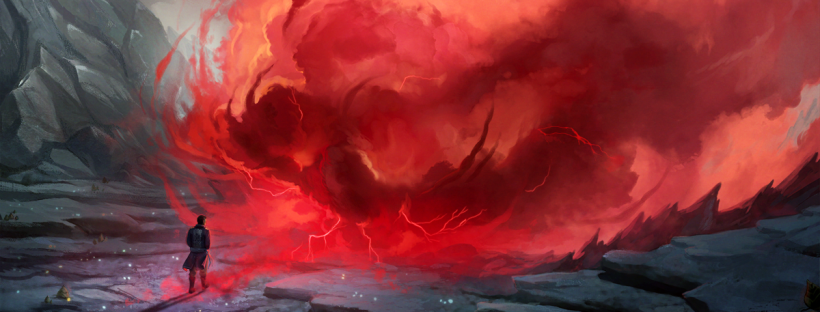
3 thoughts on “Dalinar Kholin: Healing in the Search for Wholeness”